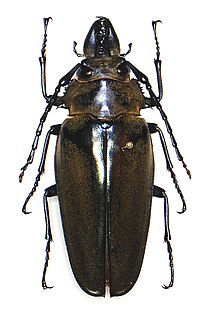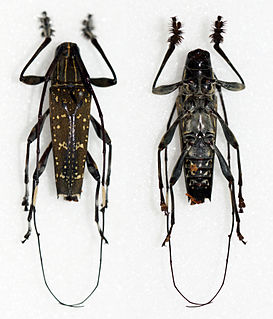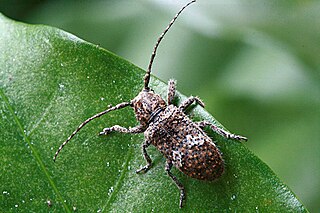
The longhorn beetles (Cerambycidae), also known as long-horned or longicorns, are a large family of beetles, with over 35,000 species described. Most species are characterized by extremely long antennae, which are often as long as or longer than the beetle's body. In various members of the family, however, the antennae are quite short and such species can be difficult to distinguish from related beetle families such as the Chrysomelidae. The scientific name of this beetle family goes back to a figure from Greek mythology: after an argument with nymphs, the shepherd Cerambus was transformed into a large beetle with horns.

Giovanni Antonio Scopoli was an Austrian physician and naturalist. His biographer Otto Guglia named him the "first anational European" and the "Linnaeus of the Austrian Empire".

The Chrysomeloidea are an enormous superfamily of beetles, with tens of thousands of species, mostly in the families Cerambycidae and Chrysomelidae, the leaf beetles.

Chahuis or xamoes are the common names given in Mexico to a variety of edible insects within the insect order Coleoptera. The insects' common names in English are often sticks worms, rhinoceros beetle, or just grub.

Lamiinae, commonly called flat-faced longhorns, are a subfamily of the longhorn beetle family (Cerambycidae). The subfamily includes over 750 genera, rivaled in diversity within the family only by the subfamily Cerambycinae.

The Disteniidae are a small family of beetles in the superfamily Chrysomeloidea, traditionally treated as a group within the Cerambycidae.

The Oxypeltidae are a small family belonging to the superfamily Chrysomeloidea, widespread in the Andean region of Chile and Argentina. They have traditionally been considered a group within the Cerambycidae.

The Trictenotomidae are a small family of beetles in the suborder Polyphaga containing fifteen species in two genera. Most species are found in the Oriental realm where they live in montane forest habitats. The family is considered, based on larval characters as well as sequence-based studies, to be closely related to the Salpingidae.
Trachyderini is a tribe of long-horned beetles in the family Cerambycidae. There are at least 140 genera and 650 described species in Trachyderini.
Lepturgantes is a genus of beetles in the family Cerambycidae, containing the following species:

Colobothea is a genus of longhorn beetles of the subfamily Lamiinae.
Trichostixis orientalis is a species of beetle in the family Cerambycidae, and the only species in the genus Trichostixis. It was described by Stephan von Breuning in 1936.
Dmytro Zajciw was a Ukrainian and Brazilian entomologist, notable for his collection and for his many beetle discoveries. He was born in Velyka Mykhailivka, Ukraine and died in Rio de Janeiro, Brasil. He was the author of Two new genera and species of neotropical Longhorn beetles , 1957, Contribution to the study of Longhorn beetles of Rio de Janeiro , 1958, and was the first to describe the genera Adesmoides and Pseudogrammopsis, as well as the species Beraba angusticollis and Mionochroma subaurosum, among many others.

Aristobia reticulator is a species of beetle in the family Cerambycidae. It is known from Bhutan, Myanmar, India, China, Laos, Bangladesh, Thailand, and Vietnam. It feeds on Prunus persica, Liquidambar formosana, Quercus acutissima, Prunus salicina, and Nephelium mutabile. Many references list the name as Aristobia testudo, but this name, though published earlier, is unavailable under the ICZN, primarily in that Johann Eusebius Voet's 1778 work giving the name testudo fails to fulfill the requirement in ICZN Article 11.4 that a work must be consistently binominal; none of Voet's 1778 names, including testudo, are available.
Pseudoechthistatus acutipennis is a species of beetle in the family Cerambycidae. It was described by Chiang in 1981.
Pseudoechthistatus obliquefasciatus is a species of beetle in the family Cerambycidae. It was described by Maurice Pic in 1917. It is known from China.
Velleda murina is a species of beetle in the family Cerambycidae. It was described by James Thomson in 1858. It is known from the Republic of the Congo, Equatorial Guinea, and Gabon.

Rhytiphora bankii is a species of beetle in the family Cerambycidae. It was described by Johan Christian Fabricius in 1775, originally under the genus Lamia. It is known from Australia, the Philippines, Borneo, Java, Micronesia, New Guinea, Hawaii, Moluccas, Sumatra, Vietnam, and has been introduced into Japan. It feeds on Agave sisalana.. The Australian species of Prosoplus were synonymised with Rhytiphora in 2013.
Phytoecia gianassoi is a species of beetle in the family Cerambycidae. It was described by Sama in 2007 and later reclassified to the subgenus Coptosia within the genus Phytoecia.
Podabrocephalus is the only genus in the beetle family Podabrocephalidae, or alternatively, included in the highly diverse family Cerambycidae. Its only species is Podabrocephalus sinuaticollis. It is known from southern India.











